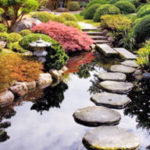What makes the Japanese gardens so different? What are the main aspects of Japanese gardens that characterize them and at the same time distinguish them from Western garden architecture?
The gardens were always associated with spiritual life in Japan. Using its own symbolism and poetic narrature, they formed an ideal landscape for calming the mind. Among other things, they are characterized by harmony and balance, space, specific lines, the feeling of Wabi and Sabi, enclosed by the privacy of the garden and own beauty in every season.
 Balance
Balance
One of the most important aspects highlighted in all Japanese gardens is a balance. Everything fits together. Everything in the garden should be balanced, but not necessarily even. This balance is more focused on space and how individual elements of the garden together form a whole, less emphasis on symmetry. Space should be used as an element in its own way, just like any other element in the garden. The individual components of the garden should be carefully selected and included in odd numbers, such as one or three or five stones, trees or other elements. There should be no even number of items.
 Space
Space
Space is another element used differently in the Japanese garden than in our gardens. Our gardens are often full of greenery and colourful flower plants. Japanese gardens use space and balance to create a complete look. In this style of gardens, it is true that less is more. With fewer components, each component means more and each has greater weight and greater impact on overall appearance. One thing that all Western people notice when looking at Japanese gardens is that gardens often seem empty. But in a Japanese-style garden space is a part that helps define the elements that surround it. This again relates to the idea of balance. Space defines the elements inside and is defined by the things inside it.
 Line of the garden
Line of the garden
In the Japanese garden, the linearity is an important part of the garden design. Squares or lines that are too straight and rough angles are very artificial. The lines and angles are therefore rather rounded and organic. Garden components should work together as well as in nature. This is the reason why things should come in odd numbers because it contributes to a natural asymmetry.
 Wabi and Sabi in the garden
Wabi and Sabi in the garden
One component of Japanese gardening philosophy, which is sometimes difficult to understand, is the Wabi and Sabi. These two terms cannot be easily translated. Wabi is literally translated to “lonely” (more on the meaning of the word Wabi here), but in the case of Japanese gardens, it rather expresses “unique” or “special”. If an item in your garden is Wabi, it will act as a contrast component while still containing the spirit of your space. Many Japanese gardens used to form the sense of Wabi, for example, stone lanterns.
 Sabi, on the other hand, translates to something like “patina” (more about the meaning of the word Sabi here). When creating a Japanese garden, it is used more as a way of expressing that something has an ideal idea; or in the case of balancing Wabi and Sabi, it means that your distinctive piece should reflect the idea/appearance of your space. Often it also involves some wear and age because old and worn pieces have a natural and narrative appearance. The new stone lantern can be Wabi, but there is no Sabi, and the stone wrapped in moss can create Sabi while missing
Sabi, on the other hand, translates to something like “patina” (more about the meaning of the word Sabi here). When creating a Japanese garden, it is used more as a way of expressing that something has an ideal idea; or in the case of balancing Wabi and Sabi, it means that your distinctive piece should reflect the idea/appearance of your space. Often it also involves some wear and age because old and worn pieces have a natural and narrative appearance. The new stone lantern can be Wabi, but there is no Sabi, and the stone wrapped in moss can create Sabi while missing  Wabi. There are many ways to balance this. A special tree, a lantern, or a particularly interesting stone, all of this with a patina and a reflective spirit of the garden, is a great example of a well-balanced wabi-sabi.
Wabi. There are many ways to balance this. A special tree, a lantern, or a particularly interesting stone, all of this with a patina and a reflective spirit of the garden, is a great example of a well-balanced wabi-sabi.
In a simplified manner, wabi-sabi element in the garden can be described as acceptance and perhaps as a celebration of an impermanence of life around.
Garden behind walls
Japanese gardens are mostly closed, private. Having a garden open to the rest of the world is very rare in Japanese gardens. On the contrary, it is quite common that a Japanese garden is surrounded by a wall as if enclosed in its own microcosm. It protects from an outside world disturbing the carefully designed balance.
The beauty of the garden all year round
 Japanese gardens are designed and maintained so that the owner or visitor can enjoy such gardens at all seasons. Each season brings a slightly different scene, a slightly different beauty.
Japanese gardens are designed and maintained so that the owner or visitor can enjoy such gardens at all seasons. Each season brings a slightly different scene, a slightly different beauty.
























